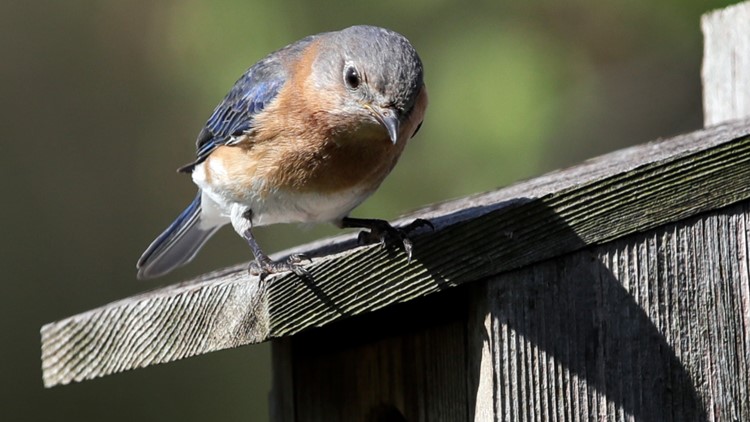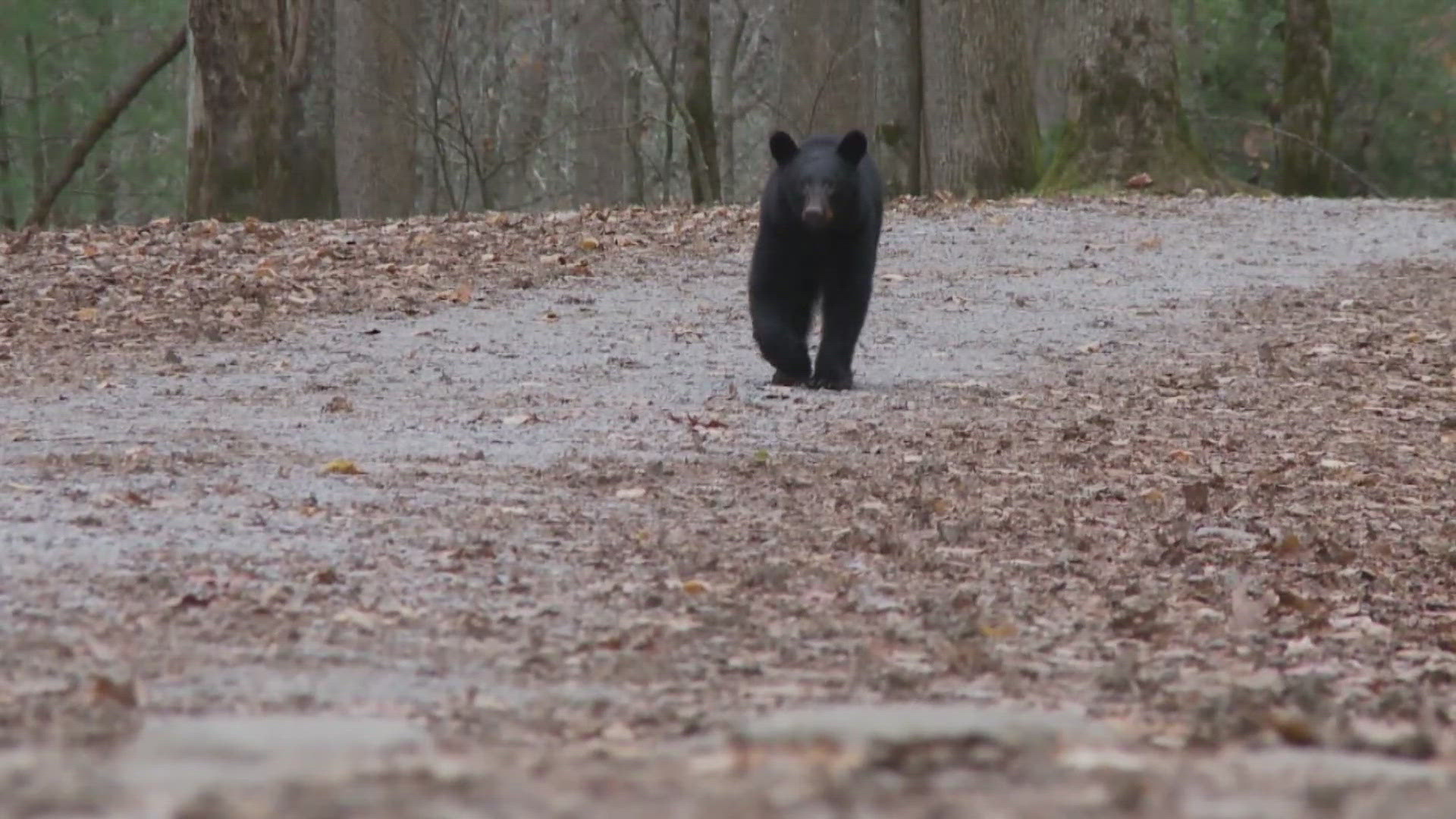ST. LOUIS — On March 30, 1927, the eastern bluebird was officially designated the Missouri state bird by an act of the Missouri Legislature because it was "common in Missouri" and "a symbol of happiness."
This was an appropriate selection in every respect. Referring to its pleasing color, naturalist Henry David Thoreau once wrote that "it carries the sky on its back."
Add to that its delightful song, non-aggressive manner and beneficial food habits, and you have a truly appealing bird. And, people can even become involved with this state bird by building birdhouses.
Most important for a state symbol, bluebirds are fitting for Missouri.
They seem to favor the rolling Missouri countryside where they may be seen flitting about from fencepost to fencepost on any bright spring morning. For those who witness the flash of blue and hear their "cheer-cheeryup" song in such a setting, the phrase "bluebird of happiness" takes on a special meaning.
Population Trends
The number of bluebirds in Missouri has varied over time in response to many factors. The Breeding Bird Survey indicates high numbers in recent years.
People who believe bluebirds are becoming rare may have moved from the country to the city during their lives or witnessed their local habitat become brushy. Still, bluebirds are not without problems.
The removal of dead trees and branches for firewood or neatness continues to eliminate existing or potential nest cavities. If it were not for the many Missourians who maintain nesting boxes, bluebirds would probably be far worse off.
The Annual Cycle
Bluebirds arrive at nesting sites in February and March. The male selects a nest site and offers the female food. The female accepts the site by bringing nest material. She builds the nest. Second and even third nestings can occur through the summer until as late as August. Nest failure and re-nesting can alter the latter part of this schedule.
- January-February: Wintering flocks begin to break up.
- February: Pairs arrive on the breeding territories, begin territorial singing.
- March: First nests constructed. First eggs laid.
- April-May: First brood fledges.
- May: Second nesting initiated.
- June: Second brood fledges.
- July: Rarely, third nesting initiated.
- August: Third brood fledges.
- September-October: Bluebirds in northern Missouri begin migration.
- September-December: Family groupings gradually join larger wandering flocks from mid-September through December.
Nest Boxes
Bluebirds readily accept appropriately placed manmade nest boxes, perhaps because of a shortage of natural nesting cavities. Nest boxes have the added advantage of excluding starlings if the entrance is 1 1/2 inches in diameter. Boxes can increase the local bluebird population and offer many hours of enjoyment.
Place new boxes and clean out and refurbish existing boxes by March 1.
Place boxes in open, grassy areas with perching sites. Meadows, pastures, savannas, cemeteries or yards that are not too heavily shaded are ideal. It is best if the grass is short. Fence lines, power lines, scattered trees or nearby woods provide good perches. Boxes placed in forests, inner cities, shaded yards, cultivated fields or areas with only tall grass will probably be unsuccessful.
For best results, mount the box on a lone post. Posts can be fitted with a 24-inch-long metal sleeve to discourage climbing predators. Posts in fence rows can become overgrown with brush, enabling black rat snakes and mice to enter the box. Tree trunks are often too shaded or easily climbed by squirrels and snakes.
- Height: 4 to 5 feet. Bluebirds nest at almost any height, but this height is convenient for checking.
- Space: 300 feet apart. This accommodates the bluebird's sizeable territory. Boxes placed closer might be used at the same time if not in sight.
The top may be mounted on a hinge, or a 1/2-inch dowel may be substituted for the hold-down strip for the roof. Either bevel the corners on the bottom or drill four 1/4-inch holes for drainage. Pine or other easily worked wood is recommended. Painting is not necessary. If painted, use light gray or tan paint.
Once a bluebird pair initiates nesting, you can open the box and check the eggs or young until they reach 13 days of age. After that, leave the young alone so that they are not frightened and do not leave the nest too early.
Clean out old nest material as soon as the young have fledged. This will help keep future nests well below the entrance hole and safer from predators. Discard the nest material at a distance so that it is not reused—handy nest material may encourage sparrows to nest in the box.
Some bluebird enthusiasts have advocated winter roost boxes to protect bluebirds on cold winter nights. Missouri Department of Conservation research has revealed that standard nest boxes provide the best shelter of any manmade structures. Occasionally, people find dead bluebirds in boxes; the birds may have been unable to forage because of snow or ice cover and would have starved regardless. Of course, natural cavities provide the best protection.
A bluebird trail is a series of boxes spaced along a route where they can be periodically monitored and maintained.
Check the houses every week to ten days for the following problems:
House sparrows: Not only are house sparrows more aggressive than bluebirds when competing for nest boxes, they will occasionally kill the young bluebirds by pecking their heads. House sparrows are not protected by state or federal law, and they should be continually discouraged by removing nests and eggs as soon as they appear. Their easily recognized nests are messy structures of grasses, feathers and assorted litter. The eggs are white and speckled with brown. If house sparrow problems continue, move boxes to at least ¼ mile away from any buildings.
Starlings: A 1 1/2-inch entrance hole will exclude starlings. Woodpeckers or squirrels, however, will sometimes enlarge holes, enabling starlings to enter. If this happens, nail a board with the properly sized hole over the front of the box. Starlings are not protected by law.
Wrens: Punctured eggs or a box filled with sticks and thorns are evidence of the house wren. Sometimes wrens even kill young and adult bluebirds by pecking their heads. Competition from wrens probably indicates that the box is too near brushy cover. House wrens are protected by law.
Other bird competitors: Boxes used by chickadees, tufted titmice, nuthatches or flying squirrels are probably in areas that are too wooded for bluebirds. Go ahead and allow these native species to use the box.
Blow flies: Both fly eggs and larvae will sometimes become established in a bluebird nest. The larvae will suck blood from young bluebirds. If this occurs, lift up the nest with your fingers and gently tap it. The larvae will fall out of the nest and can be removed from the bottom of the box.
If you are building nest boxes, please make certain that they will be looked after once in place. Boxes that are not looked after may instead benefit bluebird competitors such as house sparrows and starlings. There is evidence that neglected boxes may do more harm to bluebirds than if there were no boxes at all.
Feeding Bluebirds
Bluebirds do not eat seeds, so rarely visit ordinary bird feeders. To see bluebirds up close, attract them with special foods. Some Missourians make cakes of yellow corn meal glued together with cooled bacon drippings or similar cooking grease with bits of fruit or raisins throughout. Berries collected in summer can be dried or frozen and provided during cold weather. If the reason for feeding is to promote bluebird survival, it is better to plant dogwoods, sumacs, cedars, hawthorns or similar plants that provide natural winter foods. Fresh water is an attractant, especially in winter.
Several days of sub-freezing cold and snow or ice cover can cause mass mortality among bluebirds. It took nearly a decade for Missouri's population to recover from the hard winters of the late 1970s.
Other Blue Songbirds
The eastern bluebird has two relatives that live in western North America—the western bluebird (Sialia mexicana) and the mountain bluebird (Sialia currucoides). The latter, an all-blue species, very rarely wanders into Missouri. The most likely solid blue birds to be seen in Missouri are the male indigo bunting—a small, deep-blue bird—and its larger, look-alike cousin, the blue grosbeak.



